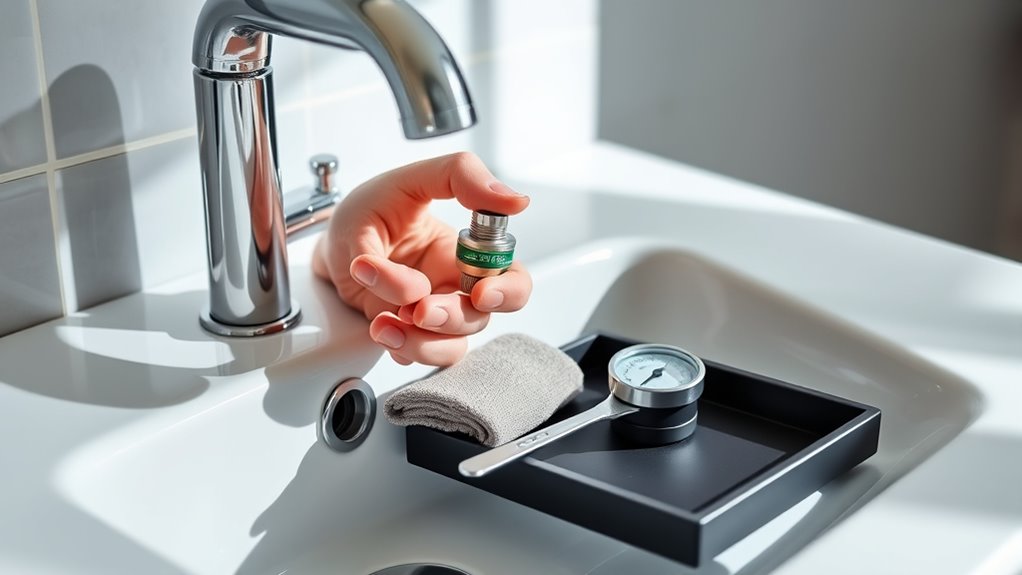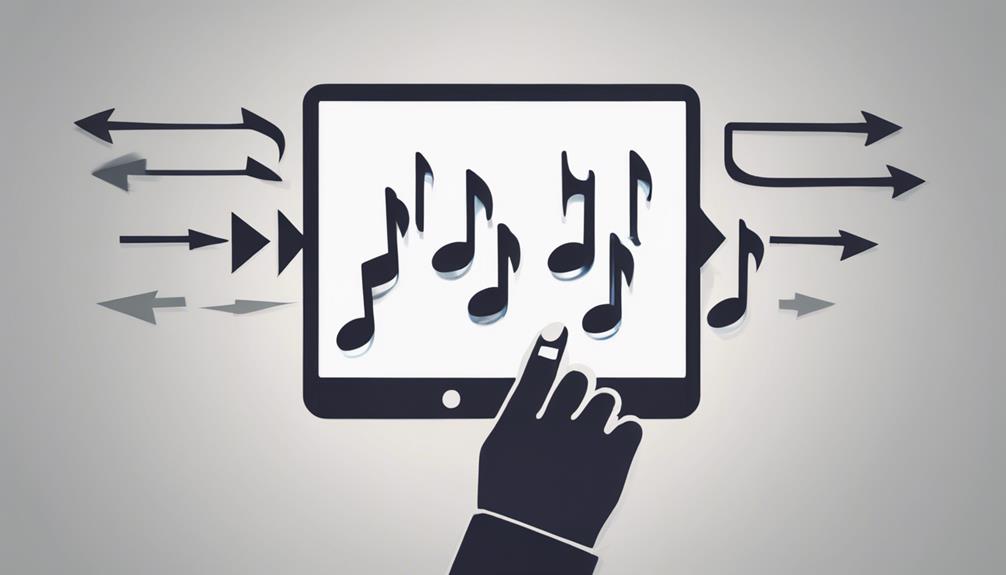To maintain peak water savings, regularly inspect your plumbing for leaks, promptly fixing any drips or cracks. Clean faucet aerators and showerheads to prevent mineral buildup, and check your toilet’s flappers and fill valves for proper function. Monitor your water pressure monthly and adjust your irrigation system for efficiency. Keep track of usage patterns and educate everyone in your household about conservation habits. Keep up with seasonal inspections—staying proactive will help you save water consistently and effectively.
Key Takeaways
- Regularly inspect plumbing fixtures for leaks and repair promptly to prevent water wastage.
- Clean aerators, showerheads, and filters periodically to maintain optimal water flow and efficiency.
- Monitor water pressure and system components to ensure proper operation and prevent overuse or damage.
- Schedule seasonal inspections of irrigation and plumbing systems to identify and fix leaks or worn parts early.
- Educate household members on water-saving practices and display maintenance tips to foster ongoing conservation efforts.
Inspect and Repair Leaks Promptly

Leaking faucets and pipes can waste a significant amount of water if left unaddressed. Regularly inspecting your plumbing helps catch leaks early, saving water and money. Check for drips around faucets and under pipes—these small leaks can add up quickly. Use water meter readings to detect hidden leaks; if your meter changes when no water is being used, you might have a leak. Installing pipe insulation can prevent pipe sweating and reduce the risk of leaks caused by temperature fluctuations. When you identify a leak, repair it promptly to prevent further damage and water loss. Keeping your plumbing in good shape not only conserves water but also extends the lifespan of your pipes, ensuring your home stays efficient and leak-free.
Clean and Clear Faucet Aerators and Showerheads

Regularly cleaning and clearing your faucet aerators and showerheads guarantees they function efficiently and conserve water. To do this, start with simple aerator cleaning and showerhead removal. Here’s what you should do:
- Turn off the water supply and unscrew the faucet aerator or showerhead.
- Soak the parts in vinegar for about 30 minutes to dissolve mineral buildup.
- Use a brush to scrub away debris, then rinse thoroughly before reattaching.
- Inspect for any wear and tear that might cause leaks or reduce water flow, and replace damaged parts as needed.
This process helps restore ideal water flow and prevents clogs. Regular aerator cleaning improves water efficiency and saves you money. Remember, proper showerhead removal and cleaning prevent water wastage, ensuring your fixtures work smoothly and effectively. Keep these tips in mind for a more eco-friendly, water-saving routine.
Check and Maintain Toilet Flappers and Fill Valves

Start by inspecting your toilet flapper for leaks, as a worn or damaged flapper can waste water continuously. Next, test the fill valve to guarantee it shuts off properly and refills the tank correctly. If you notice any worn components, replace them promptly to keep your toilet running efficiently and conserve water. Additionally, automatic flushing sensors should be checked periodically to ensure they are functioning correctly and not causing unnecessary water use.
Inspect Flapper for Leaks
Inspecting your toilet flapper for leaks is an essential step in maintaining water efficiency. A leaky flapper can waste hundreds of gallons weekly. To perform leak detection, start by adding a few drops of food coloring into the tank. Wait 10-15 minutes without flushing. If color appears in the bowl, your flapper has a leak. Next, consider flapper replacement if needed; a worn or warped flapper won’t seal properly. Ultimately, check the chain and connections to ensure they’re not tangled or too loose, which can cause leaks. Regularly inspecting your flapper helps you catch problems early, saving water and preventing costly repairs. Proper maintenance keeps your toilet functioning efficiently and minimizes water waste. Additionally, staying informed about AI safety measures can help ensure that smart home devices and plumbing systems are protected from vulnerabilities that could lead to malfunctions.
Test Fill Valve Function
To guarantee your toilet functions efficiently and conserves water, it’s important to test the fill valve’s operation regularly. Start with a fill valve inspection by lifting the tank lid and observing how the water refills after flushing. Watch for any irregularities, slow refilling, or noisy operation. Ensure the water level is properly regulated; it should be about an inch below the outlet hole. If the water level is too high or low, adjust the fill valve accordingly to maintain ideal water use. A properly functioning fill valve prevents overflows and unnecessary water waste. Regular testing helps identify issues early, allowing you to make timely adjustments. This simple routine ensures your toilet maintains efficient water level regulation and continues to save water effectively. Being aware of city water conservation guidelines can also help you stay compliant and optimize your water-saving efforts.
Replace Worn Components
Worn or damaged toilet flappers and fill valves can cause leaks, inefficient flushing, and wasted water. To prevent this, check these components regularly and replace them when signs of wear appear. Always follow safety precautions, such as turning off the water supply before starting. When considering replacement timing, replace faulty parts promptly to avoid further damage or water waste. Here’s what to do:
- Inspect for cracks, mineral buildup, or brittleness on the flapper and fill valve.
- Turn off water, drain the tank, and remove the old parts carefully.
- Install new components, ensuring a secure fit and proper function before turning the water back on.
Regular maintenance keeps your toilet running efficiently and conserves water, saving you money and supporting water conservation efforts.
Test Your Water Pressure Regularly

Make it a habit to check your water pressure gauge once a month to catch any issues early. If the pressure is too high or low, adjust your regulator to keep it within the recommended range. Regular testing helps prevent damage and guarantees your water-saving efforts stay effective. Additionally, inspecting your campground water supply periodically ensures there are no leaks or contamination issues that could compromise your water conservation.
Check Pressure Gauge Monthly
Regularly checking your water pressure gauge helps prevent plumbing issues and conserves water. Consistent pressure monitoring guarantees your system operates efficiently. Here’s what you should do:
- Read the gauge monthly to spot any sudden changes.
- Ensure gauge calibration is accurate; if the reading seems off, recalibrate or replace the gauge.
- Note the pressure levels, aiming for around 40-60 psi, to prevent strain on pipes and fixtures.
- Maintaining proper water pressure can also improve the overall performance of your plumbing system.
Keeping an eye on your pressure gauge helps catch problems early and maintain ideal flow. If the pressure is too high or low, it can indicate underlying issues that waste water or damage your plumbing. Regular checks are simple but vital for a water-saving routine.
Adjust Regulator as Needed
Testing your water pressure regularly is crucial to guarantee your system operates efficiently and conserves water. If you notice high or low pressure, it’s time for a regulator adjustment to enhance pressure regulation. Properly adjusting the regulator helps prevent leaks, reduces water waste, and extends your system’s lifespan. To determine if adjustment is needed, check your pressure gauge and compare it to recommended levels. Regular maintenance of your water-saving systems ensures optimal performance and longevity.
Adjust and Optimize Your Irrigation System

To guarantee your irrigation system works efficiently and conserves water, you should regularly adjust and fine-tune its components. Start by checking the sprinkler timing to ensure each zone waters only when needed. For drip irrigation, inspect emitters for clogs and adjust flow rates to avoid overwatering. Additionally, consider these steps:
Regularly adjust your irrigation system to save water and ensure efficient watering.
- Test your system during different weather conditions to set appropriate schedules.
- Adjust spray heads and nozzles to prevent overspray onto sidewalks or driveways.
- Regularly monitor soil moisture to refine watering times and avoid unnecessary runoff.
- Incorporate water-saving techniques such as using low-flow emitters or rain sensors to further optimize water use.
Replace Old or Inefficient Fixtures

Start by identifying fixtures that are outdated or leak regularly, wasting water and increasing your bills. Then, select water-efficient models that fit your needs and space. Proper installation techniques are essential to maximize their effectiveness, ensuring they function efficiently and have a longer lifespan.
Identify Outdated Fixtures
Old or inefficient fixtures can substantially increase your water usage and utility bills. Look for signs like constant leaks, cracks, or rust on antique fixtures and decorative faucets. These outdated fixtures often aren’t designed to conserve water and can waste gallons daily. To identify them, focus on:
- Visual signs of aging, such as corrosion, discoloration, or leaks.
- Fixtures that look mismatched or overly ornate, indicating they’re older models.
- Constant dripping from faucets or toilets that never stop, signaling replacement needs.
If you notice any of these issues, it’s time to contemplate upgrading. Replacing old fixtures with modern, water-efficient options can significantly reduce water waste and lower your bills. Don’t ignore signs of wear—your water savings depend on it.
Choose Water-Efficient Models
Choosing water-efficient models when replacing outdated fixtures is one of the most effective ways to reduce water consumption. Look for smart showerheads that limit flow without sacrificing pressure, helping you save water during every shower. Consider installing water-saving appliances like low-flow toilets and faucets, which are designed to use less water while maintaining performance. These models often come with features that optimize flow and prevent leaks, making sure you don’t waste water over time. Upgrading to these efficient fixtures not only cuts your water bill but also reduces the strain on local water resources. When selecting new fixtures, check for water efficiency labels or certifications to ensure you’re making the most eco-friendly choice. This simple upgrade makes a significant impact on your overall water conservation efforts.
Proper Installation Techniques
Proper installation is crucial to guarantee your water-saving fixtures function effectively and reliably. Following the right installation guidelines ensures your fixtures perform at their best. Start by gathering the necessary tool requirements, such as a wrench, screwdriver, and plumber’s tape. Then,:
- Turn off the water supply before removing old fixtures.
- Carefully follow the manufacturer’s instructions for installing the new fixture.
- Check for leaks and tighten connections as needed, using your tools properly.
- Verify proper flushing mechanism operation to ensure waste is removed efficiently.
Monitor Water Usage Patterns
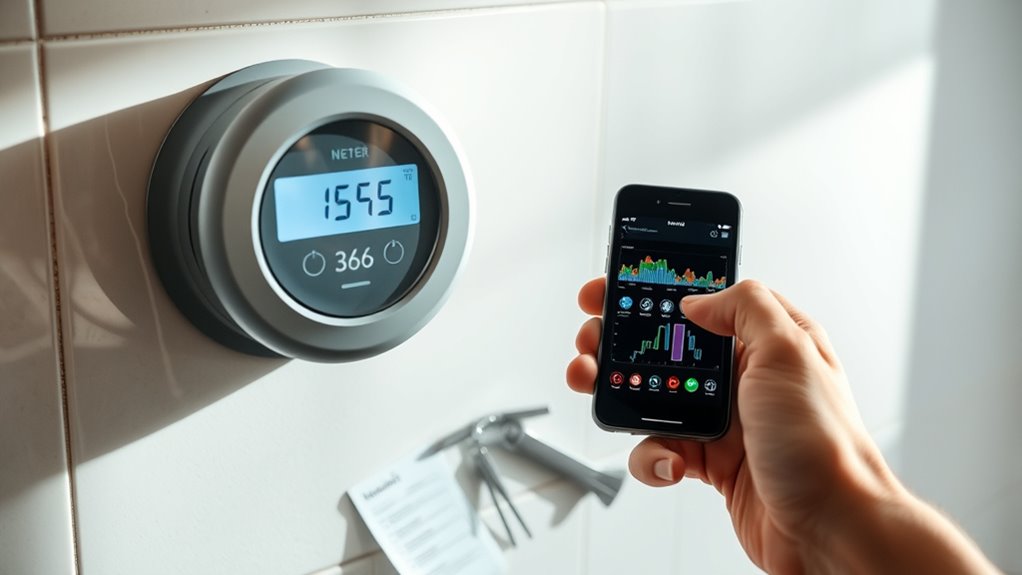
By regularly monitoring your water usage patterns, you can identify where and when you’re using the most water. This process, called water usage monitoring, helps you understand your consumption habits and spot areas for improvement. Keep track of daily, weekly, and monthly usage to see trends and anomalies. Use a simple chart or table to analyze your data for better insight. Here’s an example:
| Time Period | Water Usage (gallons) | Notes |
|---|---|---|
| Morning | 15 | Short showers |
| Afternoon | 25 | Garden watering |
| Evening | 35 | Laundry, dishes |
| Weekend | 50 | Filling pool, cleaning |
This consumption analysis allows you to target high-usage periods and make smarter water-saving choices. Implementing water conservation strategies can further enhance your efforts and reduce overall consumption.
Educate Household Members on Water Conservation
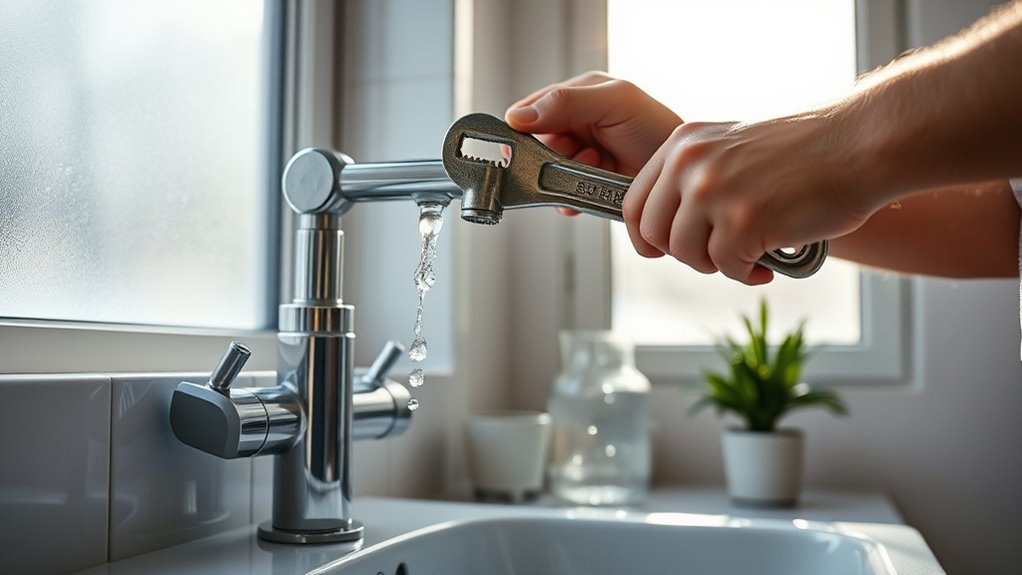
Educating everyone in your household about water conservation is essential for maximizing your efforts. When your family understands the importance of household awareness, they’re more likely to adopt water-saving habits. Start by sharing simple tips like:
- Turning off taps while brushing teeth or washing dishes
- Fixing leaks promptly to prevent water waste
- Using water-efficient appliances and fixtures
Encouraging water conservation education ensures everyone contributes. Make it easy for your household to stay informed by posting reminders or creating a quick reference guide. When each member understands their role, it becomes a team effort, notably reducing water waste. Understanding water-saving techniques and how they impact your household can motivate consistent participation. Remember, consistent water conservation education helps create lasting habits that benefit both your household and the environment.
Schedule Seasonal System Checks
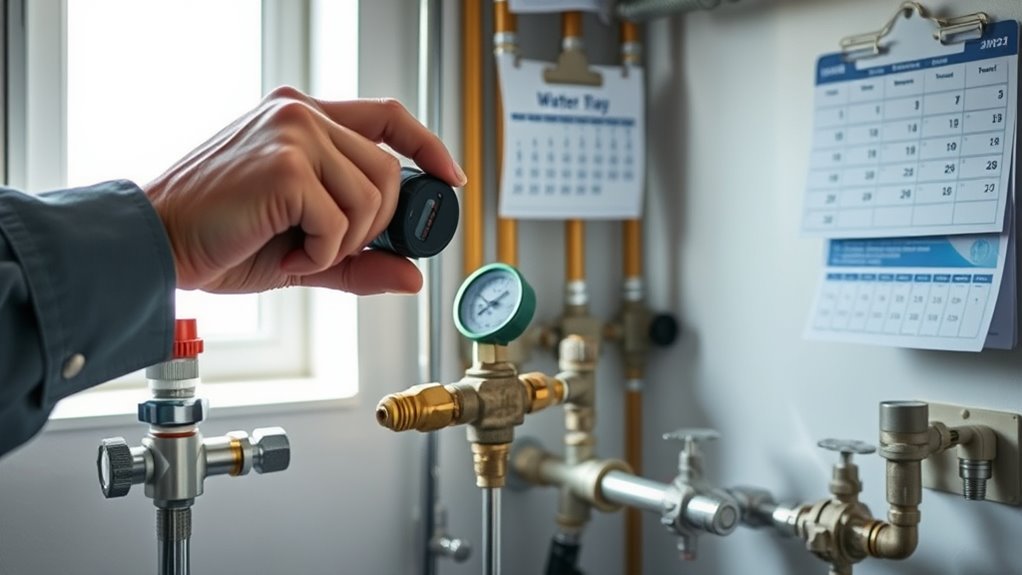
Scheduling seasonal system checks is a proactive way to maintain water efficiency throughout the year. Regular seasonal checkups help identify leaks, worn-out parts, and inefficiencies before they become costly problems. During these system maintenance sessions, inspect your faucets, toilets, and hoses for leaks or drips, and ensure that all components are functioning properly. Adjust or replace any faulty parts to prevent water waste. Checking your irrigation system, especially before summer and winter, ensures it’s operating efficiently and not overwatering or under-watering your landscape. Incorporate these seasonal checkups into your routine to catch issues early and keep your water-saving systems in excellent condition. Consistent system maintenance not only conserves water but also extends the lifespan of your fixtures and appliances. Additionally, referring to system components can help you better understand which parts may need attention during these inspections.
Keep a Maintenance Log for Water-Saving Devices
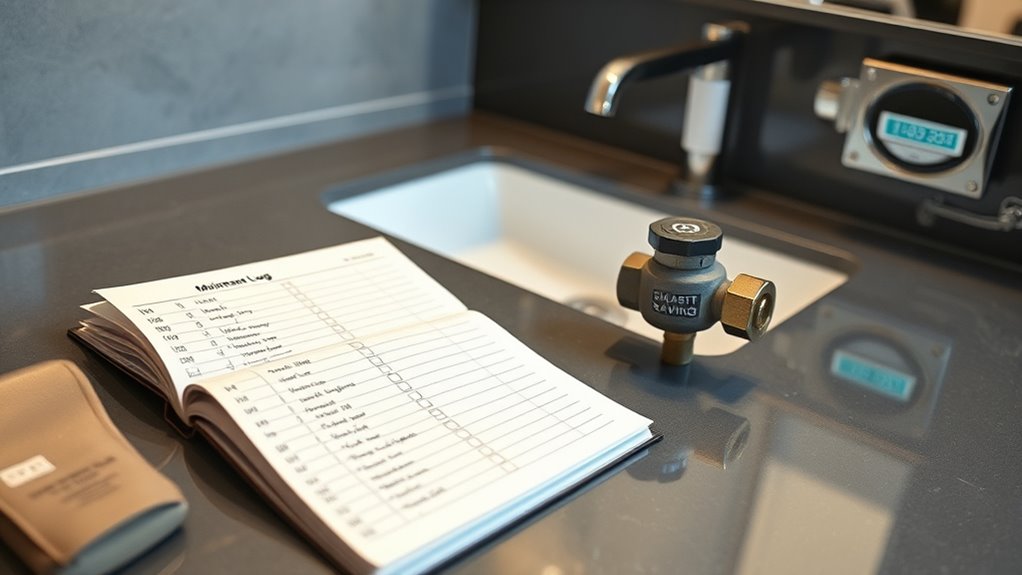
Keeping a maintenance log for your water-saving devices guarantees you stay on top of their performance and identify issues early. Regular logging helps guarantee optimal water conservation and leak prevention. To keep your system efficient:
- Record inspection dates and any repairs or replacements.
- Note signs of leaks or inefficiencies, like unusual sounds or water wastage.
- Track the performance of devices such as low-flow toilets and aerators, noting any decline in effectiveness.
- Use monitoring indicators to ensure your devices are functioning properly and alert you to potential problems.
This habit helps you catch problems before they escalate, saving water and reducing costs. Staying organized with a log makes it easier to schedule timely maintenance, ensuring your water-saving devices work at peak efficiency and extend their lifespan. A well-maintained system promotes consistent water conservation efforts.
Frequently Asked Questions
How Often Should I Perform Routine Water System Inspections?
You should perform routine water system inspections at least once every three to six months. During these inspections, focus on leak detection and system calibration to guarantee efficiency. Regular checks help catch leaks early, saving water and preventing costly damage. Keep an eye on pressure levels and look for any irregularities. By maintaining a consistent schedule, you’ll keep your water system running smoothly and optimize water conservation efforts effectively.
What Signs Indicate a Water-Saving Device Needs Replacement?
You should replace a water-saving device if leak detection reveals persistent leaks or if you notice a significant drop in performance. Devices with reduced efficiency or visible damage also indicate it’s time for a replacement. Regularly check for signs of wear, and trust in the device’s durability; when it starts to falter, replacing it ensures continued water conservation and prevents further issues. Staying vigilant helps maintain maximum water savings.
How Can I Identify Hidden Leaks in My Plumbing?
You can spot hidden leaks by watching for tiny, relentless fixture drips that seem to whisper secrets of water waste or inspecting pipes for corrosion that’s silently eating away at your plumbing. Turn off all taps and check your water meter—if it’s still spinning, you’ve got a leak lurking behind the scenes. These sneaky problems could be costing you gallons of water daily without you even realizing it!
Are There Smart Devices to Monitor Water Usage Effectively?
Yes, smart water meters equipped with leak detection technology are highly effective for monitoring water usage. These devices provide real-time data, alerting you instantly if there’s unusual consumption, which often indicates a leak. By installing smart water meters, you can proactively track your water use, identify hidden leaks early, and save water and money. They’re easy to set up and give you peace of mind knowing your plumbing is monitored constantly.
What Is the Ideal Water Pressure for Optimal Conservation?
You should aim for a water pressure of about 40-60 psi for ideal conservation. For instance, a homeowner installed a pressure gauge and adjusted their water pressure regulation system, reducing excess flow and saving hundreds of gallons monthly. Installing a pressure gauge helps monitor levels, guaranteeing your system stays within the perfect range. Proper pressure regulation minimizes waste, improves efficiency, and ensures your water-saving efforts are truly effective.
Conclusion
By staying vigilant and maintaining your water systems, you become the guardian of every drop, turning your home into a sanctuary of conservation. Each leak fixed, each nozzle cleaned, is like planting a seed of sustainability that blooms into a future where water flows freely and abundantly. Embrace this routine with dedication—your efforts are the steady heartbeat of a greener, more mindful world. Together, you can keep the flow going strong, one drop at a time.

